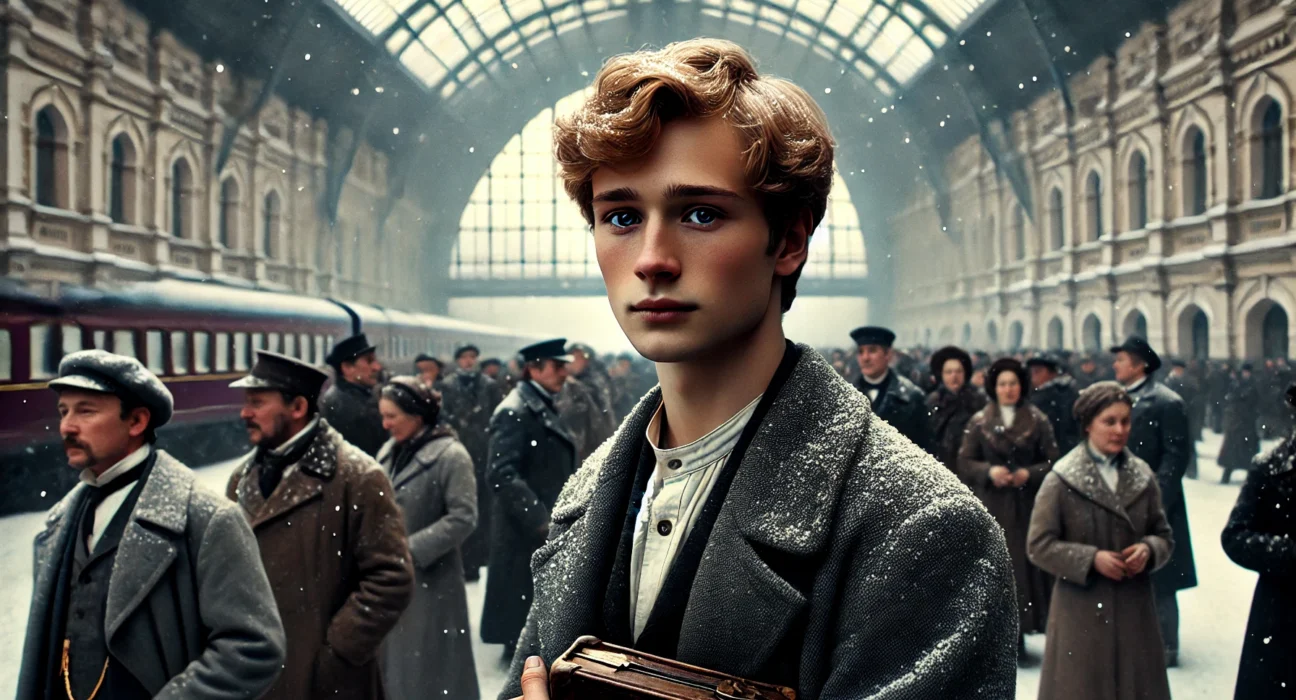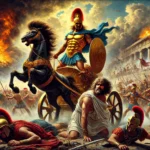“The Idiot,” written by Fyodor Dostoyevsky and first published in 1868, is a profound exploration of the human condition through the story of Prince Lev Nikolayevich Myshkin, a young man whose pure-hearted innocence and integrity stand in stark contrast to the society around him. Set in 19th-century Russia, the novel delves into themes of morality, love, and the nature of goodness, all while critiquing the social mores of Dostoyevsky’s time. The novel opens with Myshkin returning to Russia after years of treatment in a Swiss sanatorium for his epilepsy and supposed idiocy.
Comprehensive Plot Summary
On a cold November morning, a train approaches St. Petersburg, carrying Prince Lev Nikolayevich Myshkin. In the third-class carriage, Myshkin, a fair, delicate man in his late twenties, engages in conversation with a fellow passenger, Parfyon Semyonovich Rogozhin, a dark, intense young man returning to claim an inheritance. Myshkin, recently discharged from a Swiss sanatorium where he was treated for epilepsy, is returning to Russia with no money and only a small bundle of belongings.
Upon arriving in St. Petersburg, Myshkin visits General Epanchin, hoping to connect with his distant relative, Lizaveta Prokofyevna Epanchin. The general’s household, consisting of his wife and three daughters—Alexandra, Adelaida, and Aglaya—is intrigued by the prince’s simplicity and sincerity. Lizaveta is initially suspicious but grows to appreciate Myshkin’s honesty and kindness.
Myshkin soon becomes entangled in the lives of those around him. He meets Gavrila Ardalionovich Ivolgin (Ganya), who is involved in a scheme to marry Nastassya Filippovna Barashkova, a beautiful but troubled woman kept by the wealthy Totsky. Despite Ganya’s ambitions, Nastassya publicly humiliates him, torn between her desire for revenge on society and her attraction to Myshkin, whom she sees as genuinely good.
Rogozhin, deeply infatuated with Nastassya, offers her a fortune to marry him. In a dramatic scene, Nastassya throws Rogozhin’s 100,000 roubles into the fire, challenging Ganya to retrieve it, which he refuses to do, leading to a violent confrontation. Myshkin, in a compassionate gesture, offers to marry Nastassya to save her from her destructive path. Though she is initially touched, she ultimately runs away with Rogozhin.
As Myshkin integrates into society, he becomes close to the Epanchin family, particularly Aglaya, the youngest daughter. Aglaya is fascinated by Myshkin’s innocence but is also repelled by it, leading to a complex relationship. The Epanchin household becomes a battleground of emotions as Aglaya’s feelings for Myshkin deepen.
The tension culminates when Nastassya reappears, still tormented and indecisive. Myshkin, caught between his feelings for both Aglaya and Nastassya, remains steadfast in his mission to save Nastassya. A tragic love triangle ensues, leading to a final, fateful encounter.
Rogozhin and Myshkin, bound by their shared love and obsession for Nastassya, confront each other in a dramatic climax. Myshkin finds Rogozhin in a state of madness, having murdered Nastassya in a fit of jealous rage. The novel ends with Myshkin descending into a state of idiocy, and Rogozhin imprisoned, symbolizing the devastating effects of their tumultuous passions.
Myshkin’s journey begins with his arrival in St. Petersburg, a city that soon becomes a labyrinth of moral and emotional challenges for him. His first destination is the house of General Epanchin, where he hopes to find some connection to his distant relative, Lizaveta Prokofyevna Epanchin. The general’s household is a vibrant one, filled with the energy of his wife and three daughters—Alexandra, Adelaida, and Aglaya. Myshkin’s unexpected visit and his candid nature stir curiosity and skepticism among the Epanchins, but his genuine kindness begins to win them over, particularly Lizaveta Prokofyevna, who becomes intrigued by his purity and directness.
Myshkin’s path crosses with Gavrila Ardalionovich Ivolgin, known as Ganya, who is caught in a morally dubious scheme to marry Nastassya Filippovna Barashkova. Nastassya, a woman of striking beauty and deep-seated trauma, is under the financial support of Totsky, a wealthy man who wishes to marry her off to Ganya to rid himself of the scandalous connection. Nastassya, however, is not easily manipulated. During a gathering at Ganya’s home, she dramatically throws a bundle of 100,000 roubles, offered by Rogozhin for her hand in marriage, into the fire. She challenges Ganya to retrieve it, testing his greed and courage. Ganya’s refusal to stoop to the act enrages Rogozhin, leading to a confrontation that reveals the dark undercurrents of desire and desperation.
Amidst this chaos, Myshkin’s compassionate nature shines through. He offers to marry Nastassya, seeing it as a way to save her from the destructive path she is on. His proposal, however, is met with confusion and rejection. Nastassya, drawn to Myshkin’s goodness yet unable to escape her own demons, runs away with Rogozhin, who is determined to possess her at any cost.
As Myshkin becomes more integrated into society, he forms a bond with the Epanchin family, particularly with Aglaya, the youngest daughter. Aglaya is both captivated and bewildered by Myshkin’s innocence and unconventional behavior. Her feelings for him oscillate between affection and frustration, creating a complex dynamic that fuels much of the narrative tension. The Epanchin household, with its blend of ambition, societal pressure, and genuine familial bonds, becomes a microcosm of the larger societal critique Dostoyevsky weaves throughout the story.
The reappearance of Nastassya Filippovna reignites the central conflict. She is still tormented, unable to find peace or stability. Myshkin, torn between his deep compassion for Nastassya and his growing affection for Aglaya, finds himself at the center of a tragic love triangle. His unwavering commitment to save Nastassya, despite her erratic behavior and the danger it brings, underscores his saint-like qualities and his detachment from worldly desires and fears.
The climax of the story is marked by a harrowing encounter between Myshkin and Rogozhin. Their shared obsession with Nastassya binds them in a grim dance of fate. Myshkin, in a desperate attempt to prevent a tragedy, seeks out Rogozhin, only to find him in a feverish, unstable state. The two men, driven by different forms of love and madness, confront each other in Rogozhin’s darkened apartment. There, Myshkin discovers Nastassya’s lifeless body, a victim of Rogozhin’s uncontrollable jealousy and passion.
The aftermath of this tragic event leaves both men shattered. Rogozhin is arrested and imprisoned, his once fiery spirit now broken. Myshkin, overwhelmed by the enormity of the tragedy and his own inability to prevent it, descends into a state of idiocy, his mind retreating into a protective shell. The Epanchin family, witnessing the fallout, is left to grapple with the profound impact of these events on their lives.
In the end, Myshkin’s journey through the moral and emotional labyrinth of St. Petersburg serves as a poignant exploration of the human soul. His purity and goodness, juxtaposed against the corruption and complexity of the world around him, highlight the timeless struggle between innocence and experience, compassion and cruelty, love and obsession.
Main Characters
- Prince Lev Nikolayevich Myshkin: The protagonist, often perceived as an “idiot” due to his epilepsy and naivety. His genuine kindness and moral integrity set him apart in a corrupt society.
- Parfyon Semyonovich Rogozhin: A passionate and volatile man, obsessed with Nastassya Filippovna. His intense emotions and jealousy lead to tragic outcomes.
- Nastassya Filippovna Barashkova: A beautiful woman scarred by her past. Her self-destructive tendencies and complex relationship with Myshkin and Rogozhin drive much of the novel’s conflict.
- Aglaya Ivanovna Epanchin: The youngest Epanchin daughter, who becomes romantically interested in Myshkin. Her struggle between societal expectations and genuine affection for Myshkin creates internal and external conflicts.
- Gavril Ardalionovich Ivolgin (Ganya): A young man caught between ambition and morality. His involvement with Nastassya and aspirations of wealth illustrate the societal pressures and moral dilemmas faced by many characters.
Themes and Motifs
- The Nature of Goodness: Myshkin embodies the ideal of Christ-like goodness, challenging the other characters’ perceptions of morality and integrity.
- Society and Hypocrisy: The novel critiques the superficiality and corruption of Russian high society, exposing the gap between appearance and reality.
- Love and Sacrifice: The destructive power of love is a central theme, with characters like Rogozhin and Myshkin willing to sacrifice everything for their beloveds.
- Madness and Sanity: The fine line between sanity and insanity is explored through Myshkin’s epilepsy, Rogozhin’s obsession, and the societal judgment of what constitutes “normal” behavior.
Writing Style and Tone
Dostoyevsky’s writing in “The Idiot” is characterized by its psychological depth and exploration of existential themes. His narrative technique often delves into the inner thoughts and emotions of characters, creating a rich tapestry of human experience. The tone shifts from compassionate and contemplative to intense and tragic, reflecting the novel’s complex moral and philosophical questions. Dostoyevsky’s use of dialogue is particularly effective in revealing character motivations and societal critiques, making “The Idiot” a profound study of the human soul and its struggles.
If this summary has sparked your interest, we would appreciate you subscribing to our newsletter.
There’s a treasure trove of other fascinating book summaries waiting for you. Check out our collection of stories that inspire, thrill, and provoke thought, just like this one by clicking here.
If you want to request a book summary, click here.
When Saurabh is not working/watching movies/reading books/traveling, you can reach him via Twitter/X, or LinkedIn.
Restart reading!






